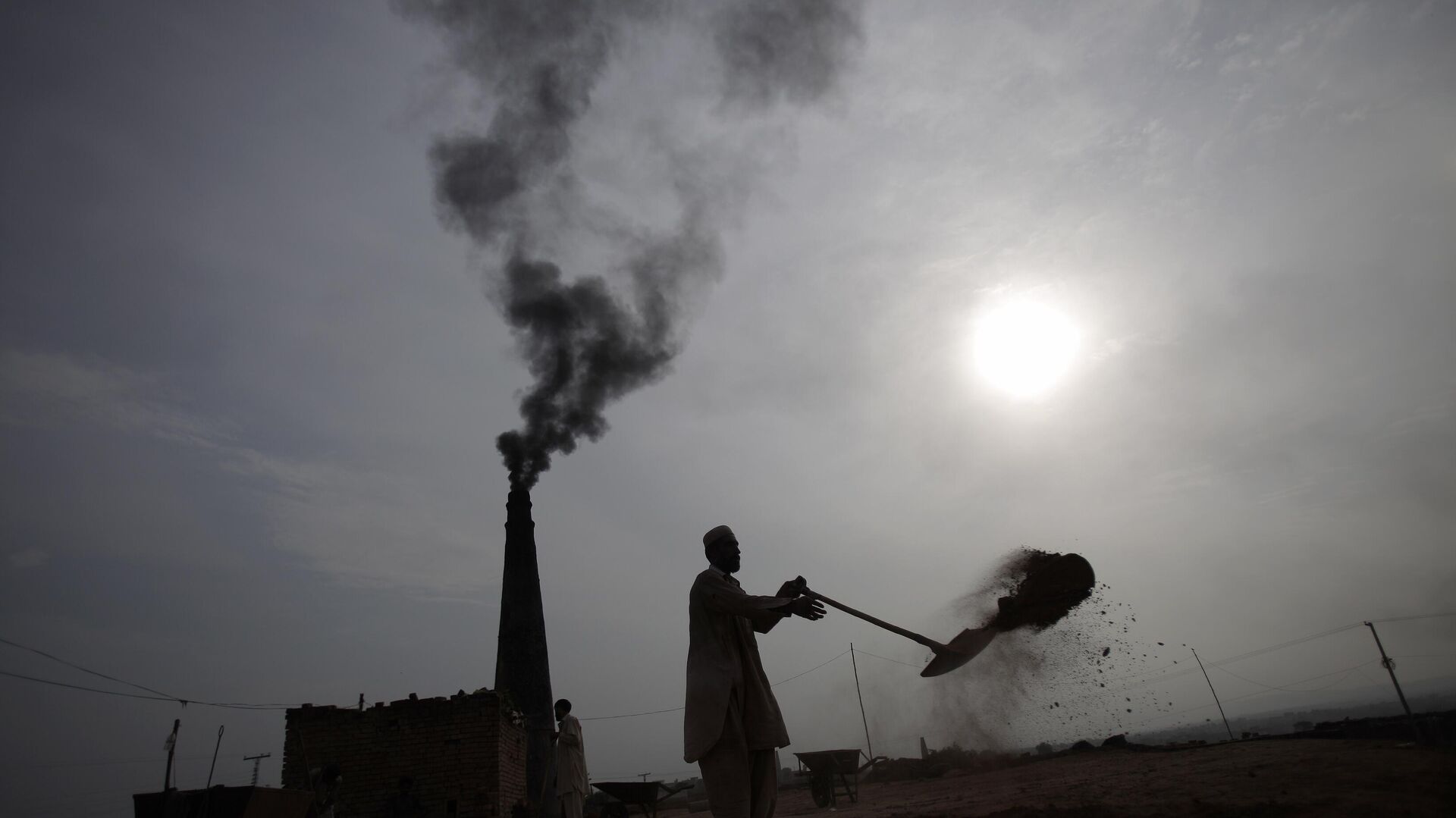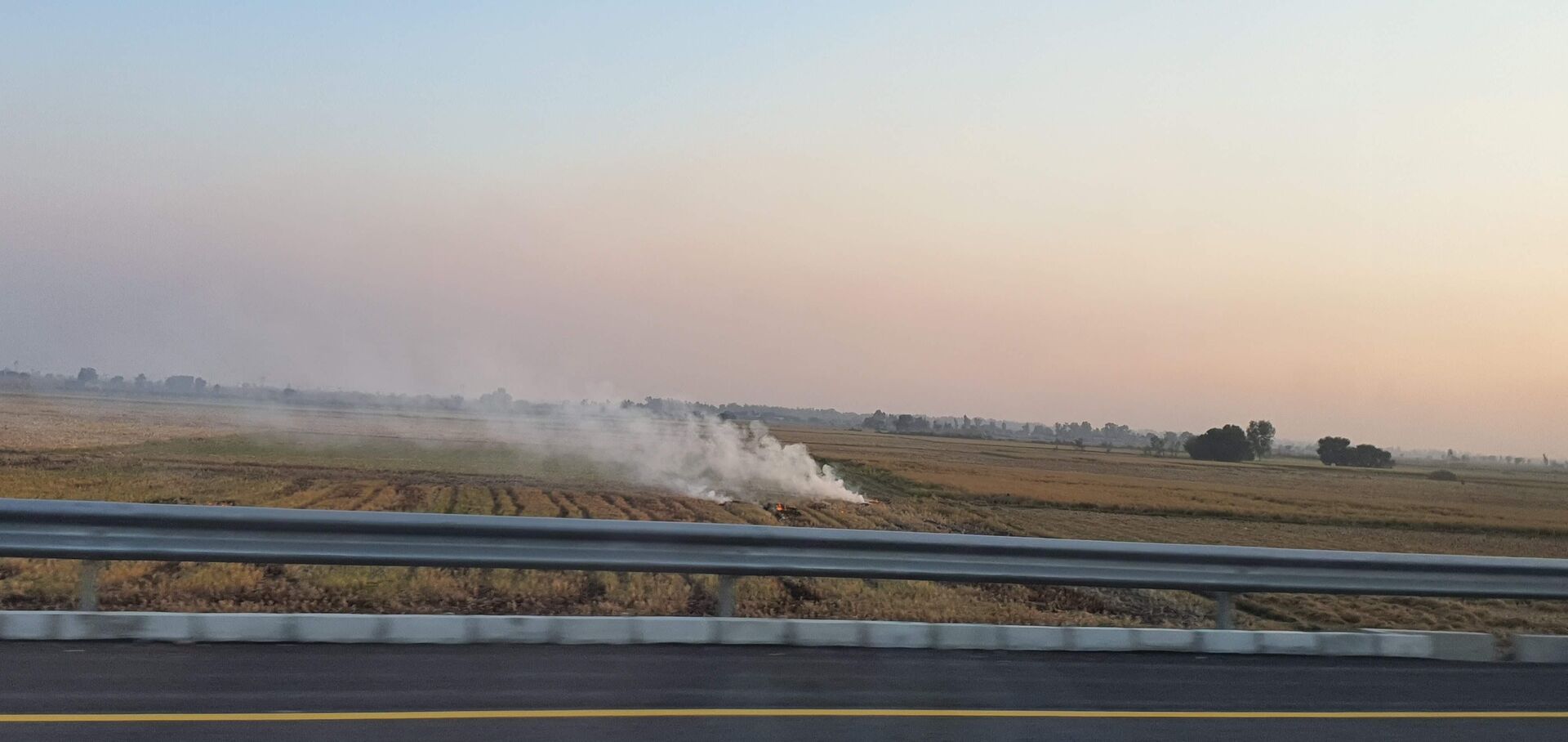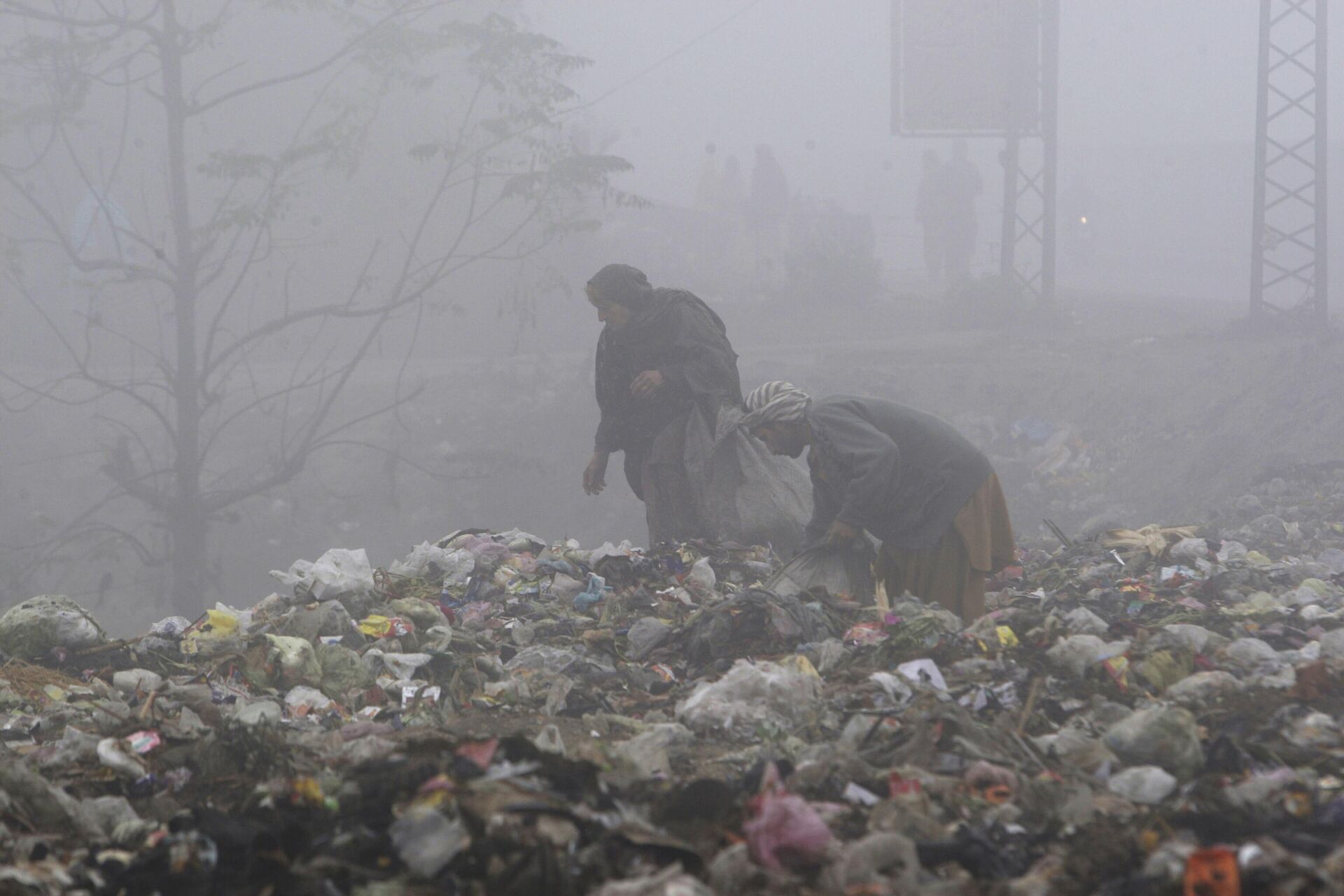https://sputniknews.in/20230916/pakistans-smog-crisis-combatting-threat-to-ozone-layer-4266459.html
Pakistan's Smog Crisis: Combatting Threat to Ozone Layer
Pakistan's Smog Crisis: Combatting Threat to Ozone Layer
Sputnik India
On the occasion of World Ozone Day on September 16, Sputnik India takes a look at how smog and pollution choking Pakistan's cities are also posing a significant threat to the ozone layer.
2023-09-16T11:18+0530
2023-09-16T11:18+0530
2023-09-16T23:42+0530
pakistan
south asia
environment
air pollution
urbanization
smog
health issues
respiratory issues
clean energy
renewable energy
https://cdn1.img.sputniknews.in/img/07e7/09/10/4273884_0:100:3284:1947_1920x0_80_0_0_f58acb9c99375563d8c58d11495ee849.jpg
Pakistan is currently facing an alarming environmental crisis, which not only poses a threat to the well-being of its people but also endangers the crucial equilibrium of the Earth's ozone layer. Smog and pollution are wreaking havoc on the atmosphere and undermining efforts to protect the planet from harmful ultraviolet (UV) radiation.The Smog Epidemic: A Looming DangerPakistan's cities, particularly Lahore, Faisalabad and Karachi, have gained notoriety for their hazardous levels of smog. When pollutants from different sources, such as vehicle emissions, industry activities, and agricultural crop burning, mix with specific weather conditions, a toxic combination of smoke and fog forms. This deadly concoction gets trapped near the Earth's surface, posing a severe threat to our environment.The consequences are dire for Pakistan's population, with skyrocketing cases of respiratory illnesses, cardiovascular problems, and even premature deaths.''The smog season in the Punjab province commences in October and persists until February,'' Mehvish Ali, a Lahore resident, told Sputnik India.The immediate health hazards are clear and the long-term effects on the environment are equally alarming.The Ozone Layer's Undercover FoeSpeaking to Sputnik India, environmentalist, urban planner and head of 'Urban Projects' Arsalan Khalid said, "What many do not realize is that the smog and pollution choking Pakistan's cities also poses a significant threat to the ozone layer".The ozone layer, located in the Earth's stratosphere, acts as a shield against the sun's harmful ultraviolet rays. This protective layer is essential to all life on Earth, as overexposure to UV radiation can lead to skin cancer, cataracts and other health problems.He also said that particulate matter (PM), which are tiny particles suspended in smog, can absorb UV radiation. This absorption leads to localised heating in the atmosphere, which can indirectly affect the ozone layer by changing temperature and circulation patterns in the stratosphere.The Global ConsequencesThe implications of a deteriorating ozone layer are not confined to Pakistan alone. The ozone layer's depletion can result in increased levels of UV radiation reaching most of the Earth's surface.Environmentalists warn that ecosystem disruption is another serious consequence caused by radiation. This harmful radiation can inflict damage upon marine ecosystems, terrestrial vegetation, and aquatic life, thereby jeopardizing biodiversity and disrupting delicate food chains.It is important to acknowledge that the Earth's protective ozone layer is gradually recovering as a result of the "Montreal Protocol" agreement reached in 1987. This treaty banned a class of chemicals called chlorofluorocarbon-11 (CFC-11), commonly used in refrigerants and aerosols. This healing of the ozone has been hailed as one of humanity's greatest ecological victories.After reaching an agreement, meetings were held during the 1990s and early 2000s to add amendments that were designed to minimize and eradicate the use of hydrobromofluorocarbons (HBFCs), methyl bromide, carbon tetrachloride, trichloroethane, and hydrofluorocarbons (HFCs).Nearly all of the planet’s governments had been working together toward this common goal and in 2023, a United Nations study found out that if countries continued to stick to the limits imposed by the Montreal Protocol and its follow-on agreements, the world could expect ozone concentrations to largely return to their pre-1980 levels by 2040.September 16 is World Ozone Day, commemorating the day in 1987 when nations signed the Montreal Protocol. The purpose of the day is to raise public awareness of the need to protect the ozone layer.Meanwhile, countries like Pakistan, India, and China must continue their efforts to reduce pollution and smog so that the ozone layer can return to normal.A Call to ActionTackling Pakistan's smog and pollution crisis is not just a matter of public health; it's an environmental imperative. To address the smog crisis effectively, the environmentalist suggests that Pakistan should transition to clean energy sources on a large scale, while also enforcing stringent emission standards for its numerous industries and millions of vehicles.The Punjab government had already taken some helpful steps by introducing public transport projects such as Metro Bus, Orange Line Train and Speedo Bus. Reforestation was also a top priority in the previous PTI government's anti-smog campaign. It also banned crop burning, a common practice in Punjab province, and imposed heavy fines on offenders.Further steps are needed, such as investing in robust air quality monitoring systems to better understand pollution sources and trends. Educating the public about the link between smog, pollution and ozone depletion could create a sense of shared responsibility.According to Khalid, Pakistan should actively work with neighboring countries to jointly address regional air quality issues, as air pollution knows no borders.Only through concerted efforts can Pakistan hope to clear the skies, protect its people, and safeguard the fragile shield that is our ozone layer.
pakistan
south asia
punjab
Sputnik India
feedback.hindi@sputniknews.com
+74956456601
MIA „Rossiya Segodnya“
2023
Aneela Rashid
https://cdn1.img.sputniknews.in/img/07e6/0c/0d/74548_0:0:485:484_100x100_80_0_0_821526e967ae85d041e2d30ee34fa1de.jpg
Aneela Rashid
https://cdn1.img.sputniknews.in/img/07e6/0c/0d/74548_0:0:485:484_100x100_80_0_0_821526e967ae85d041e2d30ee34fa1de.jpg
News
en_IN
Sputnik India
feedback.hindi@sputniknews.com
+74956456601
MIA „Rossiya Segodnya“
Sputnik India
feedback.hindi@sputniknews.com
+74956456601
MIA „Rossiya Segodnya“
Aneela Rashid
https://cdn1.img.sputniknews.in/img/07e6/0c/0d/74548_0:0:485:484_100x100_80_0_0_821526e967ae85d041e2d30ee34fa1de.jpg
pakistan's smog crisis, smog crisis in pakistan, combatting threat to ozone layer, air pollution, air pollution in pakistan, threat to the ozone layer, what is the ozone layer, the ozone layer in south asia, the ozone layer in pakistan, threats to the ozone layer, world ozone day, when world ozone day is celebrated, september 16, the smog epidemic, a looming danger, the ozone layer's undercover foe, the global consequences,
pakistan's smog crisis, smog crisis in pakistan, combatting threat to ozone layer, air pollution, air pollution in pakistan, threat to the ozone layer, what is the ozone layer, the ozone layer in south asia, the ozone layer in pakistan, threats to the ozone layer, world ozone day, when world ozone day is celebrated, september 16, the smog epidemic, a looming danger, the ozone layer's undercover foe, the global consequences,
Pakistan's Smog Crisis: Combatting Threat to Ozone Layer
11:18 16.09.2023 (Updated: 23:42 16.09.2023) On 16 September, the World Ozone Day, Sputnik India looks into how the smog and pollution in Pakistan's cities threaten the ozone layer, and what is being done to mitigate this.
Pakistan is currently facing an alarming environmental crisis, which not only poses a threat to the well-being of its people but also endangers the crucial equilibrium of the Earth's ozone layer. Smog and pollution are wreaking havoc on the atmosphere and undermining efforts to
protect the planet from harmful ultraviolet (UV) radiation.
The Smog Epidemic: A Looming Danger
Pakistan's cities, particularly Lahore, Faisalabad and Karachi, have gained notoriety for their hazardous levels of smog. When pollutants from different sources, such as vehicle emissions, industry activities, and agricultural crop burning, mix with specific weather conditions, a toxic combination of smoke and fog forms. This deadly concoction gets trapped near the Earth's surface, posing a severe threat to our environment.
The consequences are dire for
Pakistan's population, with skyrocketing cases of respiratory illnesses, cardiovascular problems, and even premature deaths.
''The smog season in the Punjab province commences in October and persists until February,'' Mehvish Ali, a Lahore resident, told Sputnik India.
"During daytime the sky turns grayish yellow with low visibility on the roads. Many Lahoris start complaining of itchy eyes, headaches and runny noses. Children develop dry coughs and often schools are closed for a week or longer when the air quality index hits hazardous levels. Many citizens, who can afford to, buy air purifiers and leave them on day and night, but each time you step outside you are exposed to these harmful pollutants," Ali shared.
The immediate health hazards are clear and the
long-term effects on the environment are equally alarming.
The Ozone Layer's Undercover Foe
Speaking to Sputnik India, environmentalist, urban planner and head of 'Urban Projects' Arsalan Khalid said, "What many do not realize is that the smog and pollution choking Pakistan's cities also poses a significant threat to the ozone layer".
The ozone layer, located in the Earth's stratosphere, acts as a shield against the sun's harmful ultraviolet rays. This protective layer is essential to all life on Earth, as overexposure to UV radiation can lead to skin cancer, cataracts and other health problems.
"Certain pollutants in the smog, notably nitrogen oxides and volatile organic compounds, can undergo complex chemical reactions in the presence of sunlight. These reactions can produce secondary pollutants, including ground-level ozone (often called "bad ozone"), which, when transported to higher altitudes, can damage the ozone layer," the environmentalist explained.
He also said that particulate matter (PM), which are tiny particles suspended in smog, can absorb UV radiation. This absorption leads to localised heating in the atmosphere, which can indirectly affect the ozone layer by changing temperature and circulation patterns in the stratosphere.
The implications of a deteriorating ozone layer are not confined to Pakistan alone. The ozone layer's depletion can result in increased levels of UV
radiation reaching most of the Earth's surface.
Environmentalists warn that ecosystem disruption is another serious consequence caused by radiation. This harmful radiation can inflict damage upon marine ecosystems, terrestrial vegetation, and aquatic life, thereby jeopardizing biodiversity and disrupting delicate food chains.
"Increased UV radiation can damage crops and reduce agricultural yields, exacerbating food security challenges. Moreover, changes in stratospheric ozone can influence the climate, potentially impacting weather patterns and climate systems," Khalid shared.
It is important to acknowledge that the Earth's protective ozone layer is gradually recovering as a result of the "Montreal Protocol" agreement reached in 1987. This treaty banned a class of chemicals called chlorofluorocarbon-11 (CFC-11), commonly used in refrigerants and aerosols. This healing of the ozone has been hailed as one of humanity's greatest
ecological victories.
After reaching an agreement, meetings were held during the 1990s and early 2000s to add amendments that were designed to minimize and eradicate the use of hydrobromofluorocarbons (HBFCs), methyl bromide, carbon tetrachloride, trichloroethane, and hydrofluorocarbons (HFCs).
Nearly all of the planet’s governments had been working together toward this common goal and in 2023, a
United Nations study found out that if countries continued to stick to the limits imposed by the Montreal Protocol and its follow-on agreements, the world could expect ozone concentrations to largely return to their pre-1980 levels by 2040.
September 16 is World Ozone Day, commemorating the day in 1987 when nations signed the Montreal Protocol. The purpose of the day is to raise public awareness of the need to protect the ozone layer.
Meanwhile, countries like Pakistan, India, and China must continue their efforts to reduce pollution and smog so that the ozone layer can return to normal.
Tackling Pakistan's smog and pollution crisis is not just a matter of public health; it's an environmental imperative. To address the smog crisis effectively, the environmentalist suggests that Pakistan should transition to clean energy sources on a large scale, while also enforcing stringent emission standards for its numerous industries and millions of vehicles.
The Punjab government had already
taken some helpful steps by introducing public transport projects such as Metro Bus, Orange Line Train and Speedo Bus. Reforestation was also a top priority in the previous PTI government's anti-smog campaign. It also banned crop burning, a common practice in Punjab province, and imposed heavy fines on offenders.
Further steps are needed, such as investing in robust air quality monitoring systems to better understand pollution sources and trends. Educating the public about the link between smog, pollution and ozone depletion could create a sense of shared responsibility.
According to Khalid, Pakistan should actively work with neighboring countries to jointly address regional air quality issues, as air pollution knows no borders.
"Controlled urbanization, stricter emission standards for vehicles, improvement of fuel quality and shifting of the industry away from the cities are all important steps, as right now Pakistan's smog and pollution crisis is a ticking time bomb with repercussions that extend far beyond its borders," Khalid added.
Only through concerted efforts can Pakistan hope to clear the skies, protect its people, and safeguard the fragile shield that is our ozone layer.





